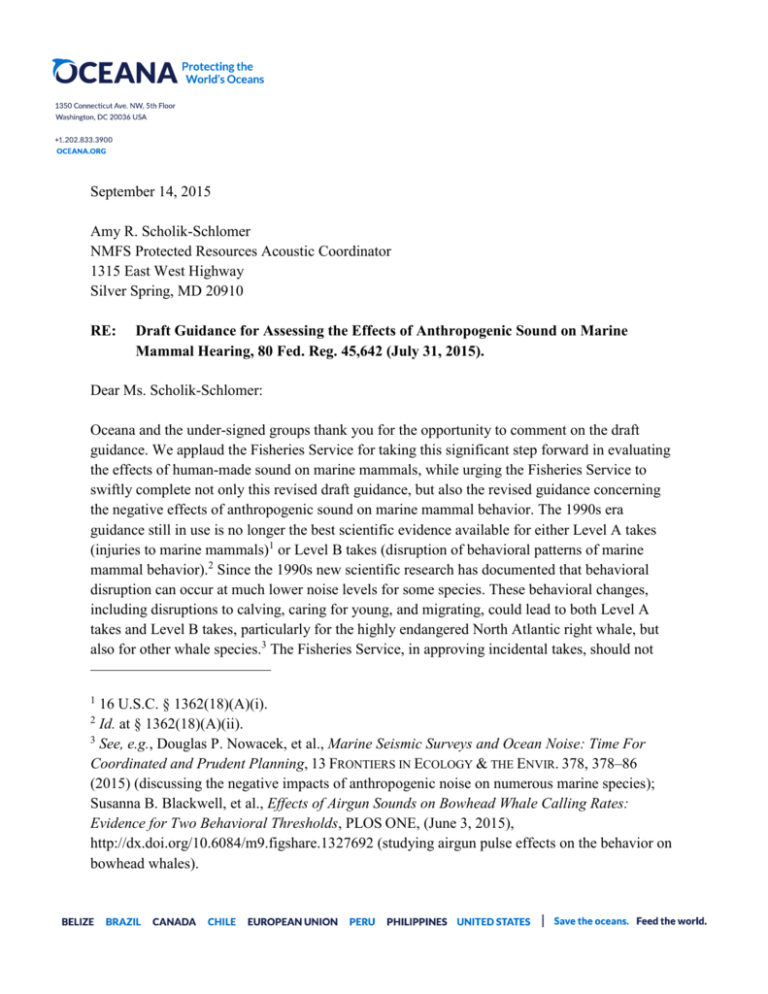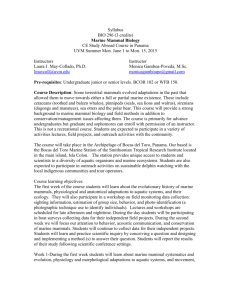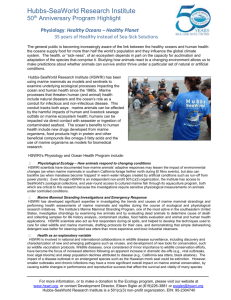Draft Guidance for Assessing the Effects of Anthropogenic Sound on
advertisement

September 14, 2015 Amy R. Scholik-Schlomer NMFS Protected Resources Acoustic Coordinator 1315 East West Highway Silver Spring, MD 20910 RE: Draft Guidance for Assessing the Effects of Anthropogenic Sound on Marine Mammal Hearing, 80 Fed. Reg. 45,642 (July 31, 2015). Dear Ms. Scholik-Schlomer: Oceana and the under-signed groups thank you for the opportunity to comment on the draft guidance. We applaud the Fisheries Service for taking this significant step forward in evaluating the effects of human-made sound on marine mammals, while urging the Fisheries Service to swiftly complete not only this revised draft guidance, but also the revised guidance concerning the negative effects of anthropogenic sound on marine mammal behavior. The 1990s era guidance still in use is no longer the best scientific evidence available for either Level A takes (injuries to marine mammals)1 or Level B takes (disruption of behavioral patterns of marine mammal behavior).2 Since the 1990s new scientific research has documented that behavioral disruption can occur at much lower noise levels for some species. These behavioral changes, including disruptions to calving, caring for young, and migrating, could lead to both Level A takes and Level B takes, particularly for the highly endangered North Atlantic right whale, but also for other whale species.3 The Fisheries Service, in approving incidental takes, should not 1 16 U.S.C. § 1362(18)(A)(i). Id. at § 1362(18)(A)(ii). 3 See, e.g., Douglas P. Nowacek, et al., Marine Seismic Surveys and Ocean Noise: Time For Coordinated and Prudent Planning, 13 FRONTIERS IN ECOLOGY & THE ENVIR. 378, 378–86 (2015) (discussing the negative impacts of anthropogenic noise on numerous marine species); Susanna B. Blackwell, et al., Effects of Airgun Sounds on Bowhead Whale Calling Rates: Evidence for Two Behavioral Thresholds, PLOS ONE, (June 3, 2015), http://dx.doi.org/10.6084/m9.figshare.1327692 (studying airgun pulse effects on the behavior on bowhead whales). 2 Draft Guidance for Assessing the Effects of Anthropogenic Sound on Marine Mammal Hearing September 14, 2015 Page 2 of 3 continue to rely on guidance that is no longer based on the best science available. Therefore, it should delay review of pending incidental take applications until both guidances have been issued. Sound is a fundamental element of the marine environment, used by marine mammals for breeding, feeding, navigating, and avoiding predators. Human-made sound, including sound from seismic airguns, sonar, explosive detonations, and construction activities, can negatively affect marine mammal hearing which can lead to disturbances in behavior that may cause serious harm. The Fisheries Service relies on its acoustic guidance to carry out its responsibilities to protect marine mammals under the Marine Mammal Protection Act (“MMPA”).4 Under the Act’s incidental take provisions, the Fisheries Service must determine when human-made sound harms marine mammals and whether the degree of incidental harm from an activity is so minor that the activity can be authorized.5 The Fisheries Service continues to evaluate and approve incidental take applications using fifteen-year-old guidance based on. In doing so, the agency has made decisions on numerous applications using out-of-date science. Currently, the agency is evaluating significant proposed activities in the Atlantic Ocean, including seismic surveying for oil and gas resources. The agency has described these actions as: [N]ot typical as the proposed surveys are very large in scale and complicated. The scale of the proposed surveys is unprecedented in U.S. waters, with some surveys involving multiple source vessels and occurring year-round throughout a broad section of the Atlantic Ocean.6 The Fisheries Service must take the necessary steps to accurately assess the effects of these proposed activities on marine mammals, particularly on threatened and endangered species such as the North Atlantic right whale. While the released proposed draft guidance is a step in the right direction, more work must be done. The agency must comply with its duty under the MMPA to protect marine mammals using 4 MMPA, 16 U.S.C. 1361 et seq. 16 U.S.C. 1371(a). 6 Email from Craig Woolcott, Congressional Affairs Specialist, NOAA, to Congressional Offices, (July 25, 2015, 4:22 PM EST) (see attached). 5 Draft Guidance for Assessing the Effects of Anthropogenic Sound on Marine Mammal Hearing September 14, 2015 Page 3 of 3 the best available science for every incidental take application that it reviews. Accordingly, the Fisheries Service must as expeditiously as possible update its guidance for all acoustic effects on marine mammals, including both hearing and behavioral effects. In the interim, the agency must immediately develop and implement an adequate plan for reviewing pending incidental take applications. The most reasonable plan would be for the agency to put all such applications on hold until it has updated all of the relevant guidance, not just the guidance on hearing effects, and only then complete its review. If the agency is unable to delay review until it has updated its guidance, it must review incidental take authorizations using the best scientific evidence available,7– not rely on out-of-date guidance from the 1990s. Sincerely, Claire Douglass Campaign Director: Climate and Energy Oceana, Inc. NAME TITLE ORGANIZATION 7 See, e.g., Nowacek, et al., supra note 3; Blackwell, et al., supra note 3.






